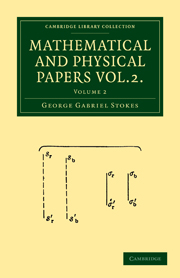Book contents
- Frontmatter
- Contents
- Notes on Hydrodynamics. III. On the Dynamical Equations
- On the constitution of the Luminiferous Ether
- On the Theory of certain Bands seen in the Spectrum
- Notes on Hydrodynamics. IV. Demonstration of a Fundamental Theorem
- On a difficulty in the Theory of Sound
- On the Formation of the Central Spot of Newton's Rings beyond the Critical Angle
- On some points in the Received Theory of Sound
- On the perfect Blackness of the Central Spot in Newton's Rings, and on the Verification of Fresnel's Formula for the intensities of Reflected and Reflacted Rays
- On Attractions, and on Clairaut's Theorem
- On the Variation of Gravity at the Surface of the Earth
- On a Mode of Measuring the Astigmatism of a Defective Eye
- On the Determination of the Wave Length corresponding with any Point of the Spectrum
- Discussion of a Differential Equation relating to the Breaking of Railway Bridges
- Notes on Hydrodynamics, VI. On Waves
- On the Dynamical Theory of Diffraction
- On the Numerical Calculation of a class of Definite Integrals and Infinite Series
- On the Mode of Disappearance of Newton's Rings in passing the Angle of Total Internal Reflection
- On Metallic Reflection
- On a Fictitious Displacement of Fringes of Interference
- On Haidinger's Brushes
- Index
On the Determination of the Wave Length corresponding with any Point of the Spectrum
Published online by Cambridge University Press: 07 September 2010
- Frontmatter
- Contents
- Notes on Hydrodynamics. III. On the Dynamical Equations
- On the constitution of the Luminiferous Ether
- On the Theory of certain Bands seen in the Spectrum
- Notes on Hydrodynamics. IV. Demonstration of a Fundamental Theorem
- On a difficulty in the Theory of Sound
- On the Formation of the Central Spot of Newton's Rings beyond the Critical Angle
- On some points in the Received Theory of Sound
- On the perfect Blackness of the Central Spot in Newton's Rings, and on the Verification of Fresnel's Formula for the intensities of Reflected and Reflacted Rays
- On Attractions, and on Clairaut's Theorem
- On the Variation of Gravity at the Surface of the Earth
- On a Mode of Measuring the Astigmatism of a Defective Eye
- On the Determination of the Wave Length corresponding with any Point of the Spectrum
- Discussion of a Differential Equation relating to the Breaking of Railway Bridges
- Notes on Hydrodynamics, VI. On Waves
- On the Dynamical Theory of Diffraction
- On the Numerical Calculation of a class of Definite Integrals and Infinite Series
- On the Mode of Disappearance of Newton's Rings in passing the Angle of Total Internal Reflection
- On Metallic Reflection
- On a Fictitious Displacement of Fringes of Interference
- On Haidinger's Brushes
- Index
Summary
Mr Stokes said it was well known to all engaged in optical researches that Fraunhofer had most accurately measured the wave lengths of seven of the principal fixed lines of the spectrum. Now he found that by a very simple species of interpolation, which he described, he could find the wave length for any point intermediate between the two of them. He then exemplified the accuracy to be obtained by his method by applying it to the actually known points, and shewed that in these far larger intervals than he ever required to apply the method to the error was only in the eighth, and in one case in the seventh, place of decimals. By introducing a term depending on the square into the interpolation still greater accuracy was attainable. The mode of interpolation depended on the known fact that, if substances of extremely high refractive power be excepted, the increment Δμ, of the refractive index in passing from one point of the spectrum to another is nearly proportional to the increment Δμ-2 of the squared reciprocal of the wave length. Even in the case of flint glass, the substance usually employed in the prismatic analysis of light, this law is nearly true for the whole spectrum, and will be all but exact if restricted to the interval between two consecutive fixed lines. Hence we have only to consider μ as a function, not of λ, but of λ-2, and then take proportional parts.
- Type
- Chapter
- Information
- Mathematical and Physical Papers , pp. 176 - 177Publisher: Cambridge University PressPrint publication year: 2009First published in: 1883



